Revolve Bundle
How Did Revolve Revolutionize Fashion E-commerce?
In the fast-paced world of online retail, how does a company like Revolve not only survive but thrive? This analysis dives into the Revolve SWOT Analysis, exploring the innovative sales and marketing strategies that have propelled the fashion e-commerce giant to success. From its inception in Southern California, Revolve has masterfully navigated the digital landscape, captivating Millennial and Gen Z consumers and setting new standards for the industry.
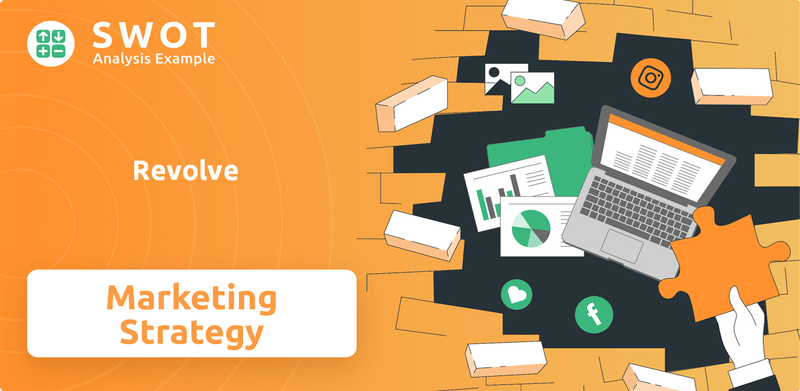
Revolve's success story is a compelling case study in modern business strategy. This exploration of Revolve's sales strategy, marketing strategy, and overall business model unveils the secrets behind its impressive growth, including its savvy use of influencer marketing and data-driven decision-making. Discover how Revolve has cultivated a strong brand, effectively targeted its audience, and optimized its marketing channel mix to achieve remarkable results in the competitive fashion market. We'll also examine Revolve marketing campaign examples, its customer acquisition strategy, and its customer retention strategies.
How Does Revolve Reach Its Customers?
The sales strategy of the company primarily revolves around its direct-to-consumer (DTC) online platform. This e-commerce-focused approach includes its website and mobile applications. This strategy is designed to engage its target audience, Millennials and Gen Z, who are digitally connected and have unique online shopping preferences.
The company's business model is centered on dynamic merchandising. This involves using real-time sales data and customer feedback to optimize product offerings. This approach allows the company to quickly adapt to trends and customer demands, helping to maintain a competitive edge in the fashion market.
Beyond its core e-commerce operations, the company has strategically expanded its sales channels. This expansion includes both online and physical retail elements, aiming to provide a comprehensive shopping experience. The company’s approach demonstrates a commitment to adapting to market changes and enhancing customer engagement.
The core of the company's sales strategy is its e-commerce platform, which includes its website and mobile applications. This digital-first approach caters to its target audience. The company's e-commerce strategy is designed to maximize convenience and personalization for its customers.
The company operates two segments: REVOLVE and FWRD. In 2024, REVOLVE accounted for 85.9% of total net sales, generating $970.5 million. FWRD contributed 14.1%, with $159.4 million in net sales. This segmentation allows the company to target different customer segments with tailored product offerings.
The company has begun to explore physical retail. The first store opened in Aspen in 2024, followed by a planned store in Los Angeles in 2025. These stores aim to combine the convenience of online shopping with personalized service. This expansion is part of the company’s growth strategy.
The company expands its reach through international marketplaces. These include Tmall Global, RED, and Douyin in China, and Nykaa Fashion in India. International net sales increased by 29% year-over-year in Q4 2024, reaching $57.1 million, and further increased by 12% year-over-year in Q1 2025. This strategy helps to reach a global audience.
The company's sales strategy is multifaceted, focusing on digital channels, strategic segmentation, and physical retail expansion. The company's approach reflects its commitment to adapting to market changes and enhancing customer engagement. For a deeper dive into the company's overall approach, check out this article on Growth Strategy of Revolve.
- Direct-to-Consumer (DTC) E-commerce: The primary sales channel is its online platform.
- Segmented Sales: Two segments, REVOLVE and FWRD, target different customer segments.
- Physical Retail Expansion: Stores in Aspen (2024) and Los Angeles (2025) test physical retail.
- International Marketplaces: Expansion through platforms like Tmall Global and Nykaa Fashion.
Revolve SWOT Analysis
- Complete SWOT Breakdown
- Fully Customizable
- Editable in Excel & Word
- Professional Formatting
- Investor-Ready Format
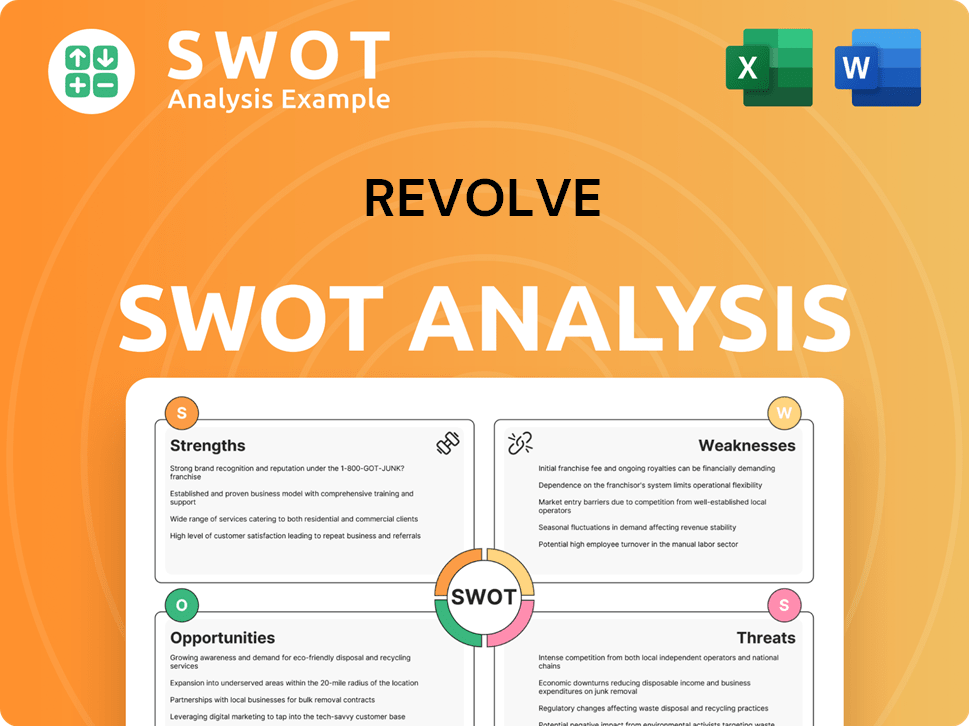
What Marketing Tactics Does Revolve Use?
The company's marketing strategy is a multifaceted approach, heavily reliant on digital tactics to boost brand awareness, generate leads, and drive sales. This strategy is strongly data-driven and incorporates significant influencer partnerships. The company focuses on creating engaging content and utilizing various digital channels to reach its target audience effectively.
A core element of the company's marketing strategy involves content marketing, which includes engaging visuals and storytelling across its platforms. Search engine optimization (SEO) and paid advertising are also utilized to enhance online visibility and reach potential customers. Email marketing is a key tool, allowing for personalized communication and promotional offers to their customer base.
Influencer marketing is central to the company's strategy, with the company collaborating with thousands of global fashion influencers. This approach significantly boosts brand visibility and sales, appealing directly to their Millennial and Gen Z target audience who value influencer recommendations. Social media platforms, such as Instagram and TikTok, are crucial for showcasing real-life product usage and engaging with their community.
The company uses content marketing to create engaging visuals and storytelling across its platforms. This includes blog posts, videos, and social media content designed to attract and retain their target audience. This strategy helps build brand awareness and drive traffic to their website.
SEO and paid advertising are used to enhance online visibility. SEO helps improve organic search rankings, while paid advertising, such as Google Ads and social media ads, allows for targeted reach. These tactics help drive traffic and sales.
Email marketing is a key tool for personalized communication and promotional offers. This includes newsletters, promotional emails, and targeted campaigns based on customer behavior. This strategy helps drive repeat purchases and customer loyalty.
The company collaborates with thousands of global fashion influencers to boost brand visibility and sales. This involves partnerships with influencers who create content featuring the company's products. This strategy is particularly effective with the Millennial and Gen Z target audience.
Social media platforms like Instagram and TikTok are crucial for showcasing real-life product usage and engaging with their community. This helps build brand awareness and drive sales. These platforms are used to create a community around the brand.
The company utilizes advanced analytics to understand customer behavior, preferences, and trends. This enables them to tailor product recommendations and personalize the customer experience. This data-driven approach helps improve customer satisfaction and drive sales.
The company's approach to marketing is highly data-driven, utilizing advanced analytics to understand customer behavior, preferences, and trends. This enables them to tailor product recommendations and personalize the customer experience. The company also invests in AI technology for site search, personalization, and inventory management, contributing to revenue gains and improved customer experience. As detailed in a recent analysis of the company's business model, marketing costs were $42.4 million, or 14.3% of net sales, in the first quarter of 2025. The company aims for marketing expenses to be between 14.9% to 15.1% of net sales for the full year 2025.
The company employs a variety of marketing tactics to reach its target audience and drive sales. These tactics are designed to be data-driven and customer-centric, focusing on personalization and engagement. The company's marketing strategy is a key component of its overall business model.
- Content marketing, including engaging visuals and storytelling.
- Search engine optimization (SEO) and paid advertising to enhance online visibility.
- Email marketing for personalized communication and promotional offers.
- Influencer marketing, collaborating with thousands of global fashion influencers.
- Social media platforms for showcasing product usage and engaging with the community.
- Data-driven strategies utilizing advanced analytics to understand customer behavior.
- Investment in AI technology for site search, personalization, and inventory management.
Revolve PESTLE Analysis
- Covers All 6 PESTLE Categories
- No Research Needed – Save Hours of Work
- Built by Experts, Trusted by Consultants
- Instant Download, Ready to Use
- 100% Editable, Fully Customizable
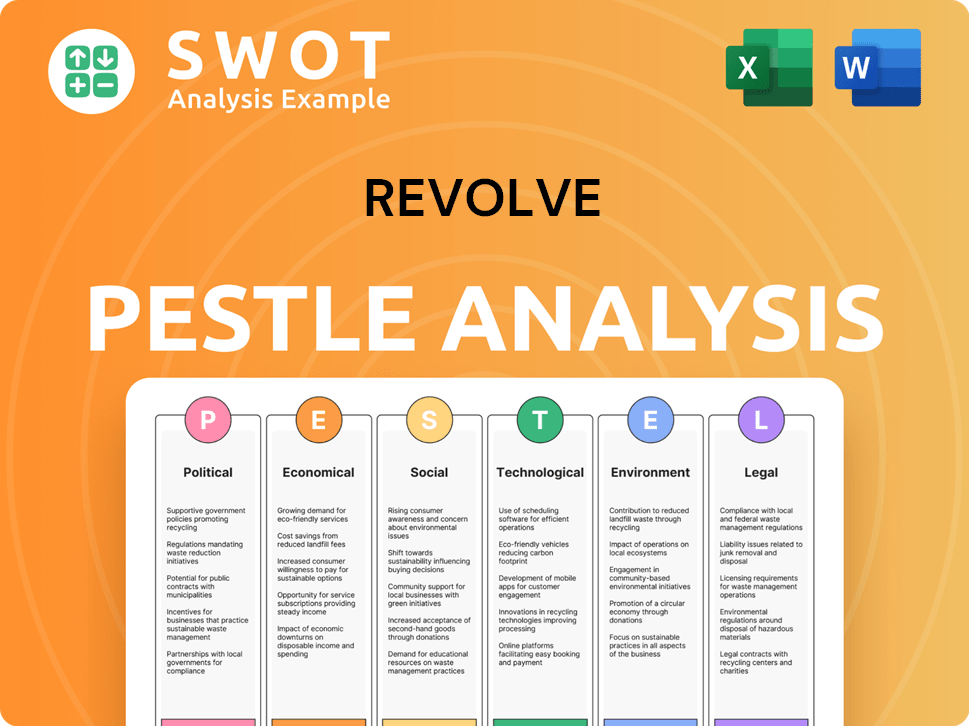
How Is Revolve Positioned in the Market?
The company strategically positions itself as a leading online fashion retailer, primarily targeting Millennial and Generation Z consumers. Its brand identity is built on offering a curated selection of trendy apparel, footwear, accessories, and beauty products. This approach is central to its Revolve brand positioning, emphasizing a fashionable and aspirational lifestyle to resonate with its target demographic.
The brand differentiates itself through its dynamic merchandising, using real-time sales data and customer feedback to quickly adapt to changing fashion trends. The core message revolves around discovery and inspiration, creating an engaging customer experience. The company's visual identity and tone of voice align with current fashion trends, fostering a strong brand identity across all channels.
A key element of the Revolve sales strategy involves a focus on its owned brands. This strategy contributed to 18% of sales in 2024, with plans for further expansion. The company's ability to maintain a strong average order value and net sales per active customer demonstrates its solid connection with its customer base. For a deeper understanding of the company's origins, you can read more in this Brief History of Revolve.
The company concentrates on Millennials and Generation Z, tailoring its marketing efforts to their preferences and digital habits. This targeted approach helps in effective customer acquisition and retention.
The company offers a curated selection of fashion items, ensuring that the products align with current trends. This approach helps in maintaining a relevant and appealing product catalog.
The company uses real-time sales data and customer feedback to quickly adapt to changing fashion trends. This agility allows the company to stay ahead of the curve.
The brand maintains consistency across all channels, from its e-commerce platform to social media. This consistency reinforces brand recognition and trust.
The company's success is evident in its financial performance and strategic initiatives. The Revolve marketing strategy focuses on maintaining a strong brand presence and engaging with its target audience.
- Average Order Value (AOV): The company maintained an average order value of $295 in Q1 2025.
- Net Sales per Active Customer: Net sales per active customer were $424 in 2024.
- Owned Brands: Owned brands contributed 18% of sales in 2024.
- Future Plans: The company plans to launch new owned brands in late 2025 and early 2026, indicating a growth strategy.
Revolve Business Model Canvas
- Complete 9-Block Business Model Canvas
- Effortlessly Communicate Your Business Strategy
- Investor-Ready BMC Format
- 100% Editable and Customizable
- Clear and Structured Layout
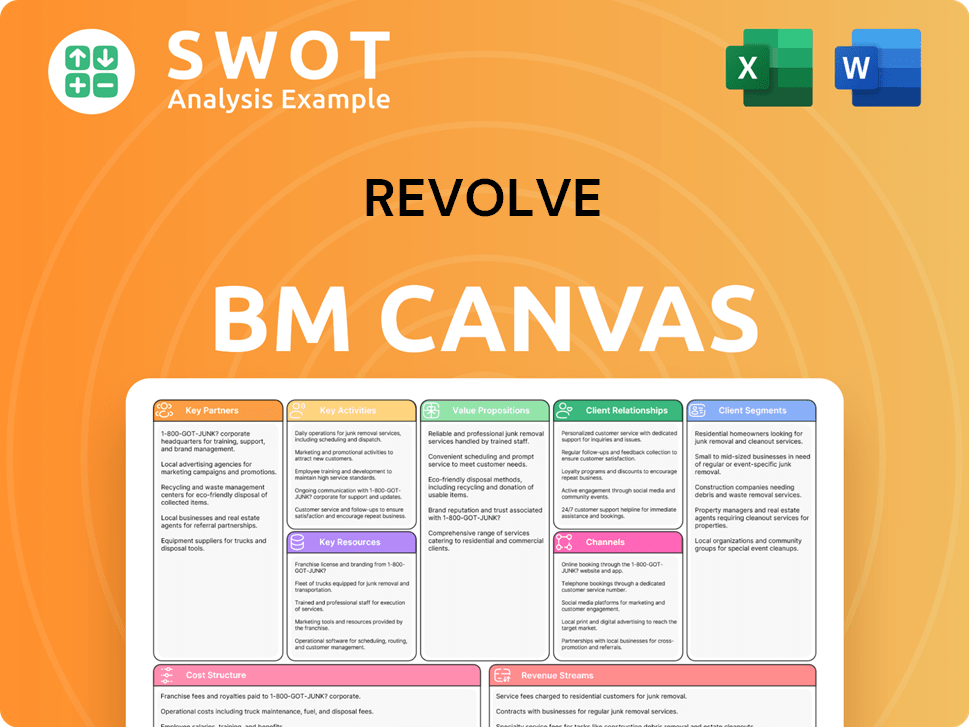
What Are Revolve’s Most Notable Campaigns?
The company's sales and marketing success hinges on strategic campaigns, particularly those leveraging influencer collaborations and experiential events. The Owners & Shareholders of Revolve understand the value of these initiatives. The REVOLVE Festival, a cornerstone of its experiential marketing strategy, exemplifies this approach. This event, often coinciding with the Coachella music festival, cultivates significant buzz and content by bringing together influencers, celebrities, and consumers.
Another critical element of the company's sales strategy involves curated 'shop-within-shop' concepts, such as the Festival and Ski Shops. These specialized initiatives allow the company to highlight specific product assortments, catering to niche interests within its broad customer base. These campaigns are designed to enhance the customer experience, driving sales and supporting category expansion.
The company's ongoing investment in AI technology also functions as a pervasive strategic initiative, driving sales and marketing effectiveness. AI is utilized for site search, personalization, and inventory management, directly impacting the customer experience and driving revenue gains. The company's exploration of physical retail expansion, with new stores in Los Angeles and Aspen, also serves as a strategic campaign to enhance customer acquisition and brand awareness by offering a tangible brand experience.
In 2025, the REVOLVE Festival demonstrated its continued effectiveness by achieving a 40% increase in press impressions and a 25% increase in social impressions, despite a reduced budget. This highlights its ability to boost brand visibility significantly. This demonstrates the power of the company's influencer marketing strategy.
Curated 'shop-within-shop' concepts, such as the Festival and Ski Shops, drove triple-digit growth in 2024. These targeted campaigns support continued category expansion in beauty, men's, and home products. This approach allows the company to cater to niche interests within its broad customer base.
The integration of AI technology for site search, personalization, and inventory management directly impacts the customer experience. This technological integration enhances product discovery and ensures tailored recommendations, leading to more efficient sales. This is a critical part of the company's digital marketing strategy.
The company's ongoing expansion into physical retail with new stores in Los Angeles and Aspen serves to enhance customer acquisition and brand awareness. This approach reflects a strategic shift towards omnichannel integration. This is a key part of the company's growth strategy.
Revolve Porter's Five Forces Analysis
- Covers All 5 Competitive Forces in Detail
- Structured for Consultants, Students, and Founders
- 100% Editable in Microsoft Word & Excel
- Instant Digital Download – Use Immediately
- Compatible with Mac & PC – Fully Unlocked
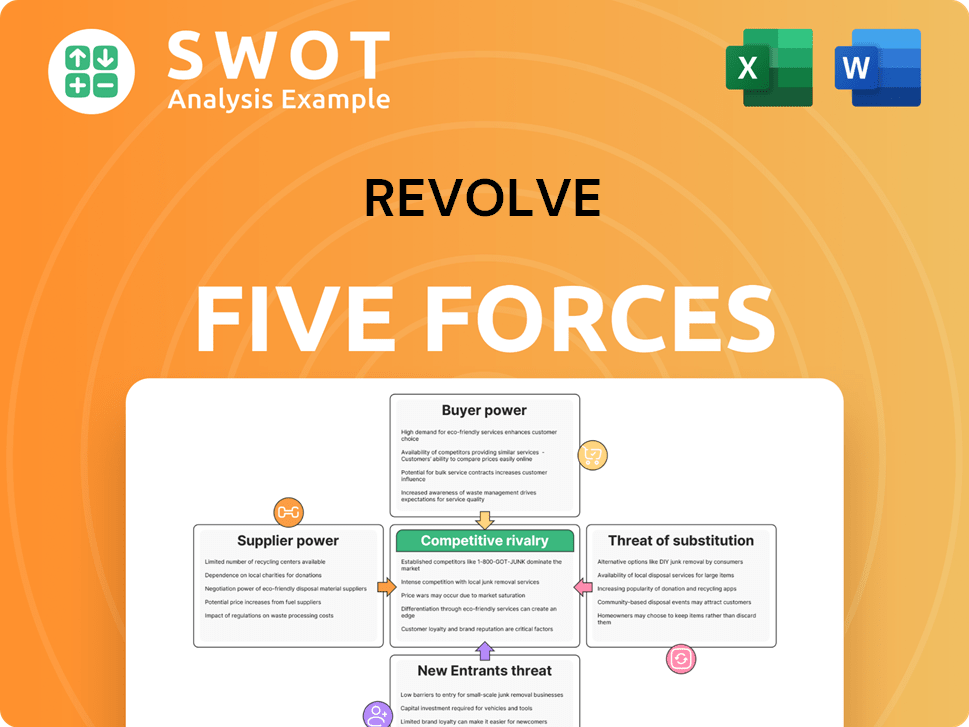
Related Blogs
- What are Mission Vision & Core Values of Revolve Company?
- What is Competitive Landscape of Revolve Company?
- What is Growth Strategy and Future Prospects of Revolve Company?
- How Does Revolve Company Work?
- What is Brief History of Revolve Company?
- Who Owns Revolve Company?
- What is Customer Demographics and Target Market of Revolve Company?
Disclaimer
All information, articles, and product details provided on this website are for general informational and educational purposes only. We do not claim any ownership over, nor do we intend to infringe upon, any trademarks, copyrights, logos, brand names, or other intellectual property mentioned or depicted on this site. Such intellectual property remains the property of its respective owners, and any references here are made solely for identification or informational purposes, without implying any affiliation, endorsement, or partnership.
We make no representations or warranties, express or implied, regarding the accuracy, completeness, or suitability of any content or products presented. Nothing on this website should be construed as legal, tax, investment, financial, medical, or other professional advice. In addition, no part of this site—including articles or product references—constitutes a solicitation, recommendation, endorsement, advertisement, or offer to buy or sell any securities, franchises, or other financial instruments, particularly in jurisdictions where such activity would be unlawful.
All content is of a general nature and may not address the specific circumstances of any individual or entity. It is not a substitute for professional advice or services. Any actions you take based on the information provided here are strictly at your own risk. You accept full responsibility for any decisions or outcomes arising from your use of this website and agree to release us from any liability in connection with your use of, or reliance upon, the content or products found herein.